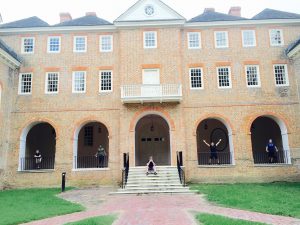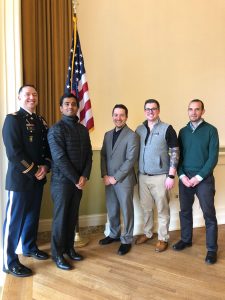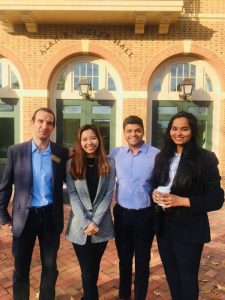Miguel Bardaji started his MBA at William & Mary in 2018
The ringing of a hundred-year-old bell. Sorrowful cries of encouragement from the hundreds of students, all veterans, who form the human corridor that emerging from the historic Wren Building extends as far as the eye can see, disappearing into the Sunken Garden. The distinctive sound of the clapping with which new members of the "Tribe" are received. These are some of the unique sounds welcoming you to William & Mary. It is one of the many traditions that ritualize the passage through this university filled with history (this, in particular, is that each new student, grade or postgraduate, has to ring the bell of the oldest building on campus and cross the human corridor that, as a welcome committee, form other students who lived the same tradition).
 Founded in 1693 and located in historic Williamsburg (part, along with Jamestown and Yorktown, of the tourist "historical triangle" that formed the epicenter of the political events that unleashed the American Revolution), the William & Mary maintains a unique position in the American university landscape, being the second oldest university in the country (after Harvard), alma mater of four presidents and the first institution of higher education in the country to establish a code of honor. Considered today a public Ivy and endowed with a well-established reputation for academic excellence, William & Mary maintains a charm of another era thanks to its elegant brick buildings and colonial architecture and its idyllic campus.
Founded in 1693 and located in historic Williamsburg (part, along with Jamestown and Yorktown, of the tourist "historical triangle" that formed the epicenter of the political events that unleashed the American Revolution), the William & Mary maintains a unique position in the American university landscape, being the second oldest university in the country (after Harvard), alma mater of four presidents and the first institution of higher education in the country to establish a code of honor. Considered today a public Ivy and endowed with a well-established reputation for academic excellence, William & Mary maintains a charm of another era thanks to its elegant brick buildings and colonial architecture and its idyllic campus.
Far from that antiquity, however, is the MBA program (Master in Business Administration) that, thanks to the generosity of the Fulbright Commission and William & Mary, is where I am studying. With the modern and award-winning Raymond A. Mason School of Business as its epicenter, the program is a reflection of the dynamic world of business and a celebration of the diversity that prevails in a global economy.
Composed by 60% of Americans and 40% of global students from 19 countries, the 2020 cohort, of which I am a part, offers the opportunity to learn firsthand about the culture and customs of other countries. The small size of the class (110 people, divided into two sections whose members change every two months to encourage interaction with different classmates) allows to know, beyond mere superficialities, the majority of the class and contributes to the family environment and community of which the university prides itself.
 One of the most valuable and distinctive ingredients of the program are the close relationships that the business school maintains with the American Armed Forces. Approximately 20% of the class is made up of retired or active military personnel. Their interesting stories liven up any personal conversation with their experience in conflict zones, unique team management and leadership. And in the case of the US Coast Guard – managing natural catastrophes and commercial and migratory conflicts – they add a layer of wealth to the day-to-day class discussions. Meanwhile, the cultural and linguistic diversity provided by the international collective, coming from countries with very different degrees of internal diversity and covering almost the entire political spectrum, from established democracies to more autocratic regimes (from the United States or Japan to China; or the Kingdom of Saudi Arabia, passing through Indonesia, Mexico or Brazil), turns each class discussion and each personal conversation into an opportunity to open your eyes to the world and learn something new.
One of the most valuable and distinctive ingredients of the program are the close relationships that the business school maintains with the American Armed Forces. Approximately 20% of the class is made up of retired or active military personnel. Their interesting stories liven up any personal conversation with their experience in conflict zones, unique team management and leadership. And in the case of the US Coast Guard – managing natural catastrophes and commercial and migratory conflicts – they add a layer of wealth to the day-to-day class discussions. Meanwhile, the cultural and linguistic diversity provided by the international collective, coming from countries with very different degrees of internal diversity and covering almost the entire political spectrum, from established democracies to more autocratic regimes (from the United States or Japan to China; or the Kingdom of Saudi Arabia, passing through Indonesia, Mexico or Brazil), turns each class discussion and each personal conversation into an opportunity to open your eyes to the world and learn something new.
 Another of the experiences that mark the passage through the Raymond A. Mason School of Business is the interaction with the Executive Partners, a network of 140+ executives, retired or active, covering almost the entire spectrum of professional sectors and functional specialties. They advise us personally, forming an integral part of multiple curricular and extracurricular activities. The Executive Partners program, unique to full-time MBA programs in the US, takes advantage of the abundant human capital concentrated in this affluent area of the state of Virginia. Each student is assigned a personal coach to develop a personal growth plan and channel the professional perspectives to which the MBA program gives access. The entire network is available for, among other possibilities, holding interviews or informative meetings, giving their opinions on how to improve your curriculum vitae, providing access to specialized contacts in various sectors and companies, or carrying out mock professional interviews. They also serve as judges in the multiple simulations and presentations that are part of the academic curriculum, providing constructive feedback and sharing their valuable perspective.
Another of the experiences that mark the passage through the Raymond A. Mason School of Business is the interaction with the Executive Partners, a network of 140+ executives, retired or active, covering almost the entire spectrum of professional sectors and functional specialties. They advise us personally, forming an integral part of multiple curricular and extracurricular activities. The Executive Partners program, unique to full-time MBA programs in the US, takes advantage of the abundant human capital concentrated in this affluent area of the state of Virginia. Each student is assigned a personal coach to develop a personal growth plan and channel the professional perspectives to which the MBA program gives access. The entire network is available for, among other possibilities, holding interviews or informative meetings, giving their opinions on how to improve your curriculum vitae, providing access to specialized contacts in various sectors and companies, or carrying out mock professional interviews. They also serve as judges in the multiple simulations and presentations that are part of the academic curriculum, providing constructive feedback and sharing their valuable perspective.
If something distinguishes the experience of doing a full-time MBA at William & Mary, however, it is almost certain that each day will be different. From the thousand and one activities organized by the school itself and by the numerous student clubs (conferences, workshops, training sessions, social events ...) to the constant involvement of the Executive Partners or the diversity of the academic curriculum, which combines the development of skills from the most quantitative to the most relational, each day is an opportunity to live something different and learn something new. While time is a precious resource, the experiences multiply if, as I try my best to do, take advantage of the many opportunities that William & Mary offers me.
The first six months of my experience have flown by and I am enthusiastic about the rest of this exciting adventure. Until May 2020, if anyone is eager to visit one of the hearts of American history, I'm waiting for you in Williamsburg!
Miguel Bardaji
Fulbright Scholar/ William & Mary 2018
This post originally appeared on the Spanish Fulbright Scholar Blog and has been translated from Spanish.